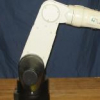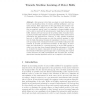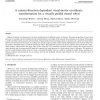122 search results - page 6 / 25 » Learning motor primitives for robotics |
ICPR
2006
IEEE
14 years 8 months ago
2006
IEEE
Most methods for visual control of robots formulate the robot command in joint or Cartesian space. To move the robot these commands are remapped to motor torques usually requiring...
IROS
2007
IEEE
14 years 1 months ago
2007
IEEE
— While underactuated robotic systems are capable of energy efficient and rapid dynamic behavior, we still do not fully understand how body dynamics can be actively used for ada...
AMS
2007
Springer
14 years 1 months ago
2007
Springer
Autonomous robots that can adapt to novel situations has been a long standing vision of robotics, artificial intelligence, and cognitive sciences. Early approaches to this goal du...
TROB
2008
13 years 7 months ago
2008
Affordances encode relationships between actions, objects and effects. They play an important role on basic cognitive capabilities such as prediction and planning. We address the p...
SGAI
2005
Springer
14 years 1 months ago
2005
Springer
Objects of interest are represented in the brain simultaneously in different frames of reference. Knowing the positions of one’s head and eyes, for example, one can compute the...



